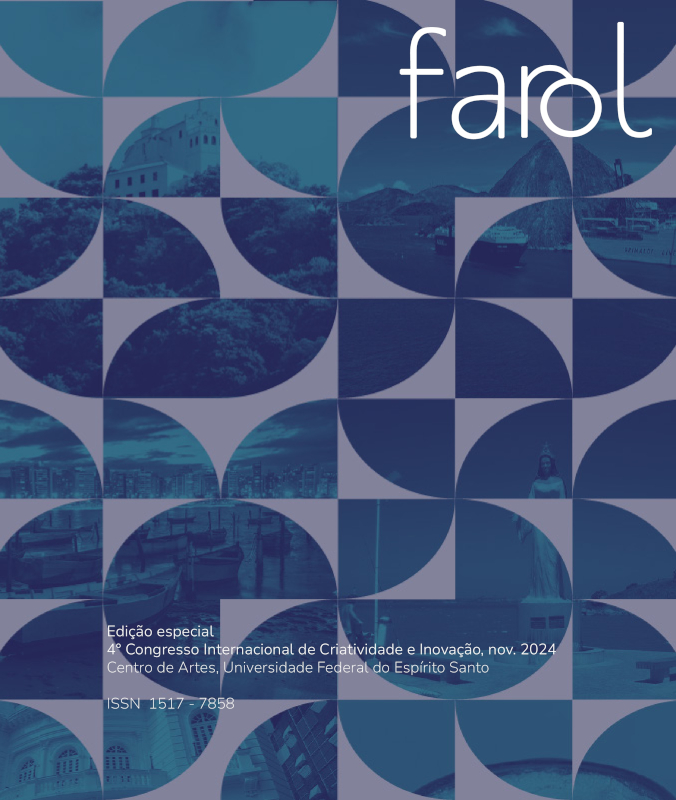Créativement, l'art éduque
Mots-clés :
criatividade, ensino de artes, educação, singularidade, estudo de casoRésumé
Ce texte aborde les spécificités du domaine de l'art et de la créativité pour réfléchir à ce qu'il peut enseigner pour l'éducation, afin de modifier les processus d'enseignement-apprentissage. Nous passons ici en revue les concepts de créativité dans le contexte éducatif, en proposant l'étude de cas comme méthode d'investigation permettant d'accéder à la singularité des étudiants en art. Grâce à cela, on s'attend à ce que les personnes faisant l'objet de recherches, les chercheurs et les éducateurs puissent exercer leur potentiel créatif et contribuer aux changements dans l'éducation, la culture et la société.
Références
BEGHETTO, R. A. Uncertainty. In Glăveanu V. (ed.) The Palgrave Encyclopedia of the Possible. Palgrave Macmillan, Cham, 2020. https://doi.org/10.1007/978-3-319-98390-5_122-1.
BEGHETTO, R. A., & KARWOWSKI, M. Unfreezing creativity: A dynamic micro-longitudinal approach. R. A. Beghetto & G. Corazza (Eds.). Dynamic perspectives on creativity, 2019. (pp. 7–25). Springer. https://doi.org/10.1007/978-3-319-99163-4_2.
CSIKSZENTMIHALYI, M. Creativity – flow and the psychology of discovery and invention. New York: Harper USA, 1997.
DUARTE JR., F. Fundamentos Estéticos da Educação. Campinas – SP: Papirus, 1994.
EISNER, Elliot W.O que pode a educação aprender das artes sobre a prática da educação? Currículo sem Fronteiras, 8 (2), 5-17, 2008.
EISNER, Elliot W. 10 ideias sobre a importância das artes segundo Elliot Eisner. Acessível em: https://artecentral.pt/10-ideias-sobre-a-importancia-das-artes-segundo-elliot-eisner/ Acesso em: 2.09.2024 às 7h59.
GLĂVEANU, V. P. Rewriting the language of creativity: The Five A's framework. Review of General Psychology, 17(1), 69–81,2013. https://doi.org/10.1037/a0029528
GRUBER, H. E. The evolving systems approach to creative work. In D. B. Wallace & H. E. Gruber (Eds.), Creative people at work: Twelve cognitive case studies (pp. 03-24). Oxford University Press,1989.
HANCHETT HANSON, M., & GLĂVEANU, V. P. (2020). "Chapter 14: The importance of case studies and the evolving systems". In Handbook of Research Methods on Creativity. Cheltenham, UK: Edward Elgar Publishing. Retrieved Sep 20, 2024, from: https://doi.org/10.4337/9781786439659.00023
KAUFMAN, J.C., & STERNBERG, R.J. (Eds.) Cambridge handbook of creativity (2nd edn). New York, NY: Cambridge University Press, 2019. https://doi.org/10.1017/9781316979839
KOZBELT, A., BEGHETTO, R. A., & RUNCO, M. A. Theories of creativity. In J. C. Kaufman & R. J. Sternberg (Eds.), The Cambridge handbook of creativity, 2010. (pp. 20–47). Cambridge University Press. https://doi.org/10.1017/CBO9780511763205.004
LUBART, T. I. Psicologia da criatividade. Porto Alegre: Artmed, 2007.
LUBART, T.I., & THORNHILL-MILLER, B. Creativity: An overview of the 7C’s of creative thought. In R.J. Sternberg & J. Funke (Eds.), The psychology of human thought. Heidelberg. Germany: Heidelberg University Press, 2019.
PELOWSKI, M., LEDER, H., & TINIO, P. P. L. Creativity in the visual arts. In J. C. Kaufman, V. P. Glăveanu, & J. Baer (Eds.), The Cambridge handbook of creativity across domains (pp. 80–109). Cambridge University Press, 2017. https://doi.org/10.1017/9781316274385.006
REY, Sandra. Por uma abordagem metodológica da pesquisa em Artes Visuais. In BRITES, Blanca; TESSLER, Elida (orgs). O meio como ponto zero: metodologia da pesquisa em artes plásticas. Porto Alegre: Ed. Universidade UFRGS, 2002.
RHODES, M. An analysis of creativity. Phi Delta Kappan, 1961. 42 (7), 305–310. https://www.jstor.org/stable/20342603
RUNCO, M.A. Education for creative potential. Scandinavian Journal of Education, 47, 317–334, 2003. https://doi.org/10.1080/00313830308598
STERNBERG, R. J., & KARAMI, S. An 8P theoretical framework for understanding creativity and theories of creativity. The Journal of Creative Behavior, 56(1), 55-78, 2022. https://doi.org/10.1002/jocb.516
SIMONTON, D.K. History, chemistry psychology, and genius: An intellectual autobiography of historiometry. In M.A. Runco & R.S. Albert (Eds.), Theories of creativity, (pp. 92–115). Newbury Park, CA: Sage, 1990.
SIMONTON, D. K. Creativity, leadership, and chance. In R. J. Sternberg (Ed.), The nature of creativity: Contemporary psychological perspectives (pp. 386–426). Cambridge University Press, 1988.
SIMONTON, D. K. Genius, creativity and leadership: A half-century journey through science, history, mathematics, and psychology. In R. J. Sternberg & J. C. Kaufman (Eds.), The nature of human creativity (pp. 302–317). Cambridge University Press,2018. https://doi.org/10.1017/9781108185936.022
WALLACE, D. B. Studying the individual: the case study method and other genres. In D. B. Wallace & H. E. Gruber (Eds.), Creative people at work: Twelve cognitive case studies (pp. 25-43). Oxford University Press, 1989.
Téléchargements
Publiée
Numéro
Rubrique
Licence
(c) Copyright Asdrúbal Borges Formiga Sobrinho, Stela Maris Sanmartin, Aparecido José Cirilo 2024

Ce travail est disponible sous licence Creative Commons Attribution - Pas d’Utilisation Commerciale - Partage dans les Mêmes Conditions 4.0 International.
Les auteurs des œuvres soumises à Revista Farol autorisent leur publication sur des supports physiques et électroniques, uniquement à des fins académiques, et peuvent être reproduites à condition de citer la source. Ils attestent de leur originalité, de leur paternité et de leur originalité.





